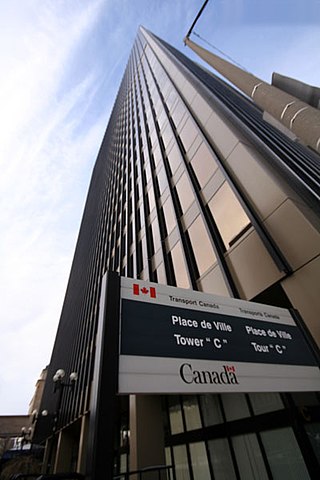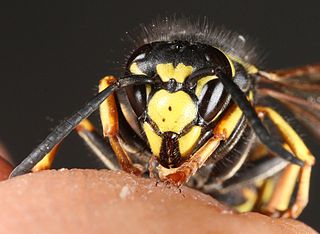
Hornets are the largest of the eusocial wasps, and are similar in appearance to yellowjackets, their close relatives. Some species can reach up to 5.5 cm (2.2 in) in length. They are distinguished from other vespine wasps by the relatively large top margin of the head. Worldwide, 22 species of Vespa are recognized. Most species only occur in the tropics of Asia, though the European hornet is widely distributed throughout Europe, Russia, North America, and north-eastern Asia. Wasps native to North America in the genus Dolichovespula are commonly referred to as hornets, but all of them are actually yellowjackets.

Vespula is a small genus of social wasps, widely distributed in the Northern Hemisphere. Along with members of their sister genus Dolichovespula, they are collectively known by the common name yellowjackets in North America. Vespula species have a shorter oculomalar space and a more pronounced tendency to nest underground than Dolichovespula.

Paper wasps are vespid wasps and typically refers to members of the vespid subfamily Polistinae, though it often colloquially includes members of the subfamilies Vespinae and Stenogastrinae, discussed elsewhere, which also make nests out of paper. Paper wasp nests are characterized by open combs with down pointing cells. Some types of paper wasps are also sometimes called umbrella wasps, due to the distinctive design of their nests.

Aviation safety is the study and practice of managing risks in aviation. This includes preventing aviation accidents and incidents through research, educating air travel personnel, passengers and the general public, as well as the design of aircraft and aviation infrastructure. The aviation industry is subject to significant regulation and oversight.

The Asian giant hornet or northern giant hornet, including the color form referred to as the Japanese giant hornet, is the world's largest hornet. It is native to temperate and tropical East Asia, South Asia, Mainland Southeast Asia, and parts of the Russian Far East. It was also found in the Pacific Northwest of North America in late 2019 with a few more additional sightings in 2020, and nests found in 2021, prompting concern that it could become an invasive species. However, by the end of the season in November 2022, there were no confirmed sightings in North America at all, suggesting they may have been eradicated in that region.

Transport Canada is the department within the Government of Canada responsible for developing regulations, policies and services of road, rail, marine and air transportation in Canada. It is part of the Transportation, Infrastructure and Communities (TIC) portfolio. The current Minister of Transport is Pablo Rodriguez. Transport Canada is headquartered in Ottawa, Ontario.

The European hornet is the largest eusocial wasp native to Europe. It is also the only true hornet found in North America, having been introduced to the United States and Canada from Europe as early as 1840. Vespines, such as V. crabro, are known for making intricate paper-like nests out of surrounding plant materials and other fibers. Unlike most other vespines, reproductive suppression involves worker policing instead of queen pheromone control, as was previously thought.

Vespula germanica, the European wasp, German wasp, or German yellowjacket is a species of wasp found in much of the Northern Hemisphere, native to Europe, Northern Africa, and temperate Asia. It has spread and become well-established in many other places, including North America, South America, Australia, South Africa, and New Zealand. German wasps are part of the family Vespidae and are sometimes mistakenly referred to as paper wasps because they build grey paper nests, although strictly speaking, paper wasps are part of the subfamily Polistinae. In North America, they are also known as yellowjackets.

Potter wasps, the Eumeninae, are a cosmopolitan wasp group presently treated as a subfamily of Vespidae, but sometimes recognized in the past as a separate family, Eumenidae.

Dolichovespula is a small genus of social wasps distributed widely throughout the Northern Hemisphere. The yellow and black members of the genus are known by the common name yellowjackets in North America, such as Dolichovespula norwegica, along with members of their sister genus Vespula. In a study on the nesting biology of Dolichovespula, a colony of D. maculata with 771 workers was reported as having the largest recorded population count.

The European paper wasp is one of the most common and well-known species of social wasps in the genus Polistes. Its diet is more diverse than those of most Polistes species—many genera of insects versus mainly caterpillars in other Polistes—giving it superior survivability compared to other wasp species during a shortage of resources.

A wasp is any insect of the narrow-waisted suborder Apocrita of the order Hymenoptera which is neither a bee nor an ant; this excludes the broad-waisted sawflies (Symphyta), which look somewhat like wasps, but are in a separate suborder. The wasps do not constitute a clade, a complete natural group with a single ancestor, as bees and ants are deeply nested within the wasps, having evolved from wasp ancestors. Wasps that are members of the clade Aculeata can sting their prey.

Polistes humilis, known as the Australian paper wasp, is a species of wasp in the family Vespidae that is found throughout Australia and which has been introduced to northern New Zealand. These paper wasps can be identified by their long thin legs and banded yellow and black coloring. They have been known to re-utilize old nests. While the species does not exhibit morphological class differences, there are distinct behavioral differences between queens and workers. In addition, the species is eusocial and benefits from relatedness between individuals. They are known for delivering a painful sting, especially when their nest is disturbed, a behavior that has been developed as a nest defense mechanism. While wasps are often viewed negatively, they play an important pollination role for many plants.

Polistes chinensis is a polistine vespid wasp in the cosmopolitan genus Polistes, and is commonly known as the Asian, Chinese or Japanese paper wasp. It is found in East Asia, in particular China and Japan. The subspecies P. chinensis antennalis is an invasive species in New Zealand, having arrived in 1979.

Vespula austriaca is an obligate parasitic wasp, parasitizing the nests of other species in the genus Vespula in the Old World. Its common host species include V. rufa in Europe, Japan, and East Siberia.V. austriaca wasps pollinate orchids.

Polistes carnifex, commonly known as the executioner wasp or executioner paper wasp, is a neotropical vespid wasp in the cosmopolitan genus Polistes.

Brachygastra lecheguana, formerly known as Nectarina lecheguana, is a species of dark paper wasp found across North and South America. It nests in underbrush in grassland-type environments, and produces honey, characteristic of the genus Brachygastra.

Vespula consobrina, commonly known as the blackjacket, is a species of stinging wasp in the family Vespidae, which includes multiple cousin species in the northern hemisphere, such as the famed german Yellow Jacket and other social wasps.

Polistes bahamensis is a large species of colourful paper wasp in the genus Polistes of the family Vespidae which occurs in the Bahamas, Florida and Louisiana. It is also said to occur in Georgia.


















